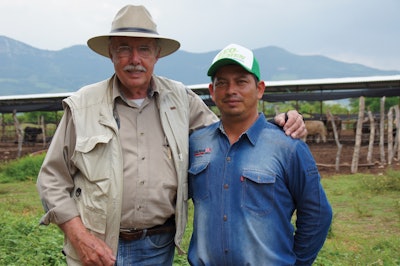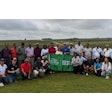
From the tropics in Campeche to the jungles in Palenque to the mountains in Tuxtla Gutiérrez, the U.S. Grains Council (USGC) is helping build markets for U.S. dried distiller’s grains with solubles (DDGS) in southeastern Mexico through demonstration trials, known locally as pruebas.
Located on the Yucatán peninsula and extending west into the connecting isthmus, southeastern Mexico is home to 9.5 million head of cattle, a third of all the cattle in Mexico. Ranchers there raise feeder calves to be consumed within the region or shipped to feedlots in northern Mexico.
The tropical climate in southeastern Mexico provides ample grass for grazing, but this boon means most ranchers in the region are unfamiliar with supplementing the local grasses. Because they stand to benefit from supplementing with DDGS significantly, USGC is working to show local producers the feed ingredient’s efficiency and value as well as to help establish regional feed suppliers offering DDGS for commercial use.
Mexico is traditionally the second-largest importer of U.S. DDGS, with countless large livestock producers actively using the product. Yet, the size and complexity of the Mexican market mean there is still significant untapped market opportunities to expand DDGS use. As a result, education and market information could spur 80,000 metric tons, by a conservative measure, of additional DDGS demand in this part of the country.
DDGS increases the rate of gain for feedlot calves in Chiapas
The rural ranch roads in Chiapas are red clay, warped by rains in the wet season and lined by living fences, in which ranchers plant seedlings that grow in the wired fence line, then trimmed down into a permanent fence post. The ranchers here, in the shadows of the Sierra Madre del Sur mountain range, purchase calves to feed for 90 to 120 days before shipping to finishing lots, primarily in northern Mexico.
Supplementing with DDGS has proven highly effective for calves in USGC’s feeding trials in Chiapas. A 2019 trial, conducted with calves on La Santina ranch, demonstrated an additional gain of 0.88 pounds per cow per day when fed DDGS.
This increased rate of gain resulted in an extra profit of 15.60 pesos per cow, per day, which totaled nearly 80,000 pesos for the 215 calves fed DDGS during the 120-day trial. The difference in body condition between cattle fed DDGS or not is also noticeable, even to an untrained eye, with smoother coats, fuller frame and increased energy.
From a nutritional standpoint, feeding DDGS also benefits the cattle’s digestive systems, fostering microorganisms in the rumen that better process the tropical forages on which the cattle graze.
By growing heavier faster, these ranchers can also send their calves to market nearly two weeks sooner, if not more. In some cases, the increased turnover time in the feedlot means ranchers have the potential to add another cycle of cattle within a year, further increasing their profit potential.
Mennonite dairy farmers innovate using DDGS
There are no powerlines or cell phone towers in Las Maravillas in Campeche state, but the German-Mexican Mennonites who have settled there are continuously expanding their dairy production and resulting cheese sales to surrounding communities. This production and market growth provide a perfect opportunity for encouraging DDGS supplementation.
This particular community moved to Campeche around 15 years ago, following a change in Mexican land laws that allowed farmers to buy and sell land. These farmers built their roads, now rutted with buggy tracks, farmsteads independent of modern conveniences like indoor plumbing and air conditioning, and a general store that supplies the community and other area residents.
That same pioneering spirit makes these producers open to new ideas for their agricultural operations, including a small generator that juices a large battery nearly the size of a presidential-sized desk that powers a cooler for the cheese they produce daily. USGC plugged into that generator to power a laptop and projector to broadcast the results of the DDGS trial conducted in 2019 in Las Maravillas on a tarp hung on the wall of their wooden meeting house.
The trials here demonstrated that supplementing with DDGS increased both milk production and fertility rates for the Mennonites’ dairy cattle. While DDGS was slightly more expensive than locally sourced commercial feed, the cows in the trial produced, on average, one liter more of milk per day when fed DDGS.
By the end of the trial, using DDGS resulted in more than 1,111 pesos in additional profit over other commercial feed per cow. The community is using the added earnings from more milk production to continue investing in their operations and expand their cheese production and sales.
Anecdotally, the ranchers in the trial reported that when tropical conditions turn into drought, dairy cows fed DDGS maintained milk production while those without supplementation saw diminished production or went dry.
The trials also demonstrated the increased fertility rates when feeding DDGS. Dairy cows grazed DDGS came into heat two months sooner than their counterparts in the trial, meaning the cows can be bred and return to active milk production faster — further increasing their production potential.
While each producer in the Mennonite community has only a few cows, the overall Mennonite population of 20,000 in southeastern Mexico is highly interconnected. As the producers who participated in this trial share their positive results with friends, neighbors and family members, USGC will continue to expand DDGS promotion efforts to other Mennonite settlements in the region.
Feed suppliers serve as crucial linchpin to expanded DDGS sales
Even with positive trial outcomes, USGC’s strategy in southeastern Mexico would not be successful without concurrent work to help these farmers and ranchers source DDGS. As a result, USGC ensures every trial presentation includes not only technical information and testimonials from the participating ranchers but also at least one or more commercial feed suppliers actively selling DDGS.
USGC consultant Eduardo Christensen called Maricruz Villalobos while attending a cattle show in Campeche to pitch U.S. DDGS as a feed ingredient.
He convinced her to try DDGS with her cattle, and since that time, she has become one of the most prominent champions for the feed ingredient in her region.
Villalobos now sells more than 100 tons of U.S. DDGS per month through her seven feed stores, including to the Mennonites, in addition to maintaining a 20% DDGS inclusion rate in her Campi-brand feed.
Trials lead to increased DDGS exports
USGC’s strategy of conducting DDGS trials with influential producers, demonstrating the results to local networks, and working hand-in-hand with feed suppliers is proving effective to measurable increases in U.S. DDGS sales to southeastern Mexico.
Regional cattle producers are now driving the demand versus only a few years ago when a single chicken plant purchased the only DDGS sold through ports in neighboring Veracruz.
USGC’s partners in southeast Mexico provide results in sales. Existing partners purchased a combined 19,600 tons of U.S. DDGS in 2017/2018, exceeding USGC’s goals for the year, with total sales to the region of more than 262,000 tons.
The support of USGC’s membership, combined with a new infusion of funding from the U.S. Department of Agriculture’s (USDA’s) Agricultural Trade Promotion (ATP) program, is fueling an expansion of these trials shortly. ■

















